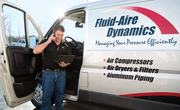What is the best way to dry compressed air? Excess moisture in your compressed air system can cause problems both within the system itself and for the applications that utilize it. Appropriate maintenance of your air compressor and the use of air dryers can remove moisture from your air and extend the life of your system. In this article, we’ll discuss the best methods for removing moisture from compressed air, including:
- Compressed air dryers (refrigerated vs. desiccant)
- Water traps and inline filtration
- The use of storage tanks for air drying
- How to drain water from the system
- Compressor maintenance
What Causes Moisture in Compressed Air?
Moisture is an inevitable byproduct of compressed air. The amount of moisture in compressed air is directly related to:
- The amount of moisture in intake air (humidity level), and
- How much the air is being compressed
All air contains a certain amount of water vapor. The volume of water held by the air varies with temperature and pressure; the higher the temperature, the more water air is able to hold. That’s why humidity tends to be higher in warmer months than in the winter.

An air compressor works by squeezing air into a smaller volume under high pressure. When a compressor draws in air, the air is compressed to about 8 times normal atmospheric pressure. Pressurized air is not able to hold as much water. As the pressure increases and temperature decreases, water vapor condenses back into a liquid. The water in the air has to go somewhere, so it forms a condensate inside the air distribution system.
Where Does Condensation Form Inside the Compressed Air System?
Moisture will tend to fall out of compressed air as it cools. Anywhere air is allowed to cool, condensation can form. Some excess moisture also stays in the compressed air stream, where it may end up in tools, equipment, or process air. Places where condensate can form include:
- Intercoolers, after-coolers, and heat exchangers
- Air receiver tanks
- Drying system
- Distribution system/piping system
- Hoses and connectors
- Equipment and tools
How Is Moisture in Compressed Air Measured?

The dew point is a measure of the moisture level of the air. The dew point is the temperature at which water falls out of the air as a condensate. The drier the air is, the colder temperatures need to be before liquid condensation forms.
How Do Seasonal Temperatures Impact Moisture in Compressed Air?
Condensation is a problem for compressed air systems in all seasons, but hot, humid air in the summertime can result in the production of large volumes of excess water. On the other hand, cold temperatures in the winter can reduce the efficiency of evaporation, allowing moisture to accumulate over time even when humidity is low. It is essential to remove excess moisture from your system in all seasons to avoid problems.

Problems Caused by Moisture in Compressed Air Systems
Excess moisture causes a number of problems, including:
- Damage to the air compressor or system components
- Damage to air-using tools, painting, and other equipment that use compressed air
- Product quality problems
- ISO compliance issues for regulated processes (e.g., food manufacturing, pharmaceuticals)
How Does Moisture Affect the Compressed Air System?
Moisture in the compressed air system can cause damage due to corrosion, blockages, icing, and water hammer events.
-
Corrosion: Corrosion is the #1 problem with excess moisture in compressed air. Corrosion is a chemical reaction between a metal, oxygen, and water; this is why metal rusts when it comes in contact with water. Keeping your compressed air system clean and dry — including tanks, lines, valves, and electronics — is essential to avoid damage to system components and prevent blockages.
-
Filter loading: Excess moisture and corrosion in the air system will load filters more quickly, causing the system to have to work harder to overcome pressure drop across the filters. Over time, this lowers the life expectancy of your filters and system.
-
Blockages in control lines: Liquid water or particulates from corrosion can also block control lines, which prevents instruments from reading and actuating properly.
-
Icing: In cold temperatures, ice can form inside the system. Ice may clog filters and block intake or drain valves, negatively impacting system performance. Because water expands when it freezes, ice formation can also crack pipes and other system components.
-
Water hammer events: Excess water may cause water hammer events, which can damage equipment and piping (you may hear this as a knocking sound in your air compressor pipes).
How Does Moisture in Compressed Air Impact Equipment, Processes, and Products?
Moisture is an important component of compressed air quality. Many applications require clean, dry air to ensure product quality and consumer safety. Moisture in compressed air can also damage pneumatic tools and machines. Problems include:
-
Equipment damage: Liquid water or high humidity in the compressed air stream may interfere with proper lubrication or lead to corrosion of air tools and pneumatic equipment.
-
Fouling of production processes: Particulate from rust that develops in air supply lines can become mixed with the air stream and damage equipment or foul production processes.
-
Process problems: If you are using a compressor to spray paint, water can cause negative visual and texture effects in the finish. Moisture may also interfere with processes such as injection molding, causing issues such as delamination in final products.
-
Product quality: Many products are moisture-sensitive, including food products, pharmaceuticals and nutraceuticals, and powder chemicals. Excess moisture during production or packaging may lead to caking, poor texture, or other issues.
-
ISO compliance: Some manufacturing processes must meet strict requirements for moisture content in compressed air to maintain compliance with ISO 8573 or other regulatory mandates.
What Is the Best Way to Dry Compressed Air?
While it’s impossible to prevent moisture from entering your air compressor, you can get rid of most of it. This is done in stages using different components throughout your system. This may include a combination of mechanical moisture separation and refrigerated or desiccant air dryers.
How to Drain Water from the Compressed Air System?

The first step in your moisture control plan is to drain excess water from the compressed air system on a regular basis. Draining the air compressor will not remove water that is still held as vapor in the air, but it will prevent excess liquid from building up within the tank and air supply lines. This can be accomplished most simply with a condensate drain valve. The drain valve is a simple device that opens to allow excess liquid to drain out of the system. They should be installed at each place where liquid accumulates, including:
- Compressor intercoolers/after-coolers, compressors should have a water separator in good working order at the discharge port that takes out 70% of the moisture created by compressing the air
- Air receiver tanks
- Air dryers
- Low points in the piping distribution system
There are three basic types of drain valves:
-
Manual drain valves: These valves are opened manually by the maintenance team to drain liquid water. Water should be drained at least once daily if the tank is drained manually.
-
Automatic timer drain valves: Automatic timer-based drain valves and float drains eliminate the need to remember to drain the collection points. An auto drain valve will automatically open to release excess liquid on a regular schedule. This can be a valuable benefit if your maintenance staff is stretched thin or if the item is not in an easily accessible location.
- Zero-loss drain valves: A zero-loss drain valve is another automated solution. It uses a float mechanism to detect when liquid water has accumulated and opens just long enough to release it. A zero-loss drain can save money by reducing the loss of air along with liquid water.

After-Coolers
When compressed air emerges from the pump, it’s hot. This temporarily keeps the water in its vapor state. As air cools down, excess water vapor condenses back into a liquid. The first place this happens is in the after-cooler system. Industrial air compressors may be either air-cooled or water-cooled. An air after-cooler brings temperatures for compressed air to within 15-20°F of ambient air temperatures; a water-cooled system can bring air temperature down to 10-15°F above water temperature. In a rotary-screw air compressor, about 70% of excess moisture in compressed air falls out in the aftercooler. This greatly increases the efficiency of the dryers. If liquid water enters a refrigerated dryer it reduces its efficiency by taking its cooling capacity just to cool the water present.
Air Receiver Tank

An air receiver tank, while primarily used for air storage, can also act as a secondary heat exchanger, allowing air to cool further naturally as it sits in the tank. With each degree of cooling, more water will fall out. This makes the air receiver tank useful for removing additional moisture from compressed air.
- A wet air tank is placed in between the aftercooler and the air dryer. This allows more water to fall out naturally, increasing dryer efficiency. This type of tank is the most useful for removing moisture from air.
- A dry air tank is placed after the dryers as a ready supply of dry, ready-to-use air. In theory, there should be little moisture left by this point, but the tank should still be equipped with a condensate drain for any moisture that accumulates.
Water Separator Filter (Water Trap)
The first stage of moisture removal for your air compression system is mechanical separation. This is done with a water separator filter (also known as a filtration water separator). These systems look like an in-line air filter or air compressor oil separator. The filter removes large amounts of moisture from the air supply with centrifugal force. Typically, a water separator filter will remove between 40–60% of the remaining water from the air. In most applications, this may or may not be dry enough.
Refrigerated Air Dryers
If further moisture removal is needed, look next to refrigerated air dryers. These dryers work by chilling the air, much like your air conditioning system. Remember that colder air holds less moisture than warmer air. The refrigerated air dryer chills compressed air to roughly 38-40°F. As the air cools, excess water vapor condenses back into a liquid. The liquid collects in a water trap and is removed through an automatic drain valve. The dry air is then reheated to room temperature before it reenters the production lines. Compressed air that is dried by this method has a dew point between 38-40°F, which is low enough for the majority of industrial compressed air applications.
Desiccant Air Dryers

Desiccant air dryers are used for applications that require very dry compressed air. These dryers work by removing water from the air through a chemical process. A desiccant is a solid that reacts chemically with water to form a bond. Most desiccant air dryers use activated alumina or molecular sieve desiccants. Compressed air is passed through a tower containing the desiccant material. Some desiccant air dryers also use heat. Depending on the model, desiccant air dryers can get compressed air down to a -40 to -100°F dew point, removing nearly all water vapor from the air stream. This is necessary for processes that require ultra-dry air or are operating at less than 34°F. These dryers use more energy than other drying systems and also consume between 5-18% of the compressed air supply in their operation. But if ultra-dry air is needed, they are the most effective method available to remove moisture from your air compressor and compressed air supply.
Compressed Air Drip Legs (Piping System Air Drying)
Drip legs are another way to remove moisture from your compressed air distribution system. What is a drip leg? It is a pipe or tube installed at a low point in the system that allows liquid water to pool so it can be drained off. Drip legs are used to plumb water from compressed air piping as air continues to cool inside the distribution system. A drip leg (or drop leg) system relies on gravity to gather condensate as it forms. It may have several drop points with a drain or water trap at each point. Compressed air gets progressively drier as it moves through the piping system as temperature drops.
Drip legs will be especially important if you are not using an air-drying system and relying solely on natural condensation in your system. If your air is already very dry after leaving the dryers and entering the piping system, there may not be much moisture left to drain from here. However, it is always advisable to have a method to drain liquid from the piping system if any should accumulate. Drains on drip legs may be manual or automated.
Absorption Drying
Absorption drying systems are not as common as refrigerated or desiccant air dryers, but this method does still have some applications. While desiccant dryers use adsorption, this method uses chemical absorption. An absorptive material reacts with the water to remove it from the system. Absorbents commonly used for air drying include water-soluble sodium chloride or sulfuric acid. The materials cannot be regenerated like an adsorptive desiccant; they must be replaced as they become saturated or dissolve. While cost-effective and simple, this method can leave behind residues in the system and does not lower the dew point as much as refrigerated or desiccant dryers. It also requires materials to be replaced frequently. These drawbacks have made absorption technologies less popular for compressed air drying.
Can You Use a Deliquescent Air Dryer for Compressed Air?
Deliquescent air dryers are not recommended for industrial compressed air applications. These systems use a desiccant material, like a desiccant air dryer, but produce a liquid effluent as water reacts with the material. The effluent must be drained frequently and may require hazardous waste disposal methods. There is also a risk of corrosive effluent entering the compressed air supply.
How to Keep Moisture Out of the Air Compressor
One way to reduce excess moisture in your compressed air is to lower the humidity of air going into the compressor, placing it where ambient temperatures are lower. When intake air is drier, the drying systems have less work to do to get air down to the required dew point. Air compressor maintenance is also very important to keep moisture out of the compressor.
Compressor Room Environment

If the compressor is located outdoors, there may not be much you can do to reduce the humidity of intake air (unless you can avoid making air when the weather is damp). If the compressor is indoors, you will have more control over the quality of the intake air. Keeping the compressor room cool, well-ventilated, and dry will reduce the burden on air-drying equipment. Some steps you can take:
- Make sure the compressor room has plenty of ventilation to keep temperatures down, reduce moisture buildup and prevent compressor overheating.
- Consider insulating your compressor room for better temperature control.
- Add a dehumidifier to the compressor room.
- Fix leaks and don’t allow water to pool on the floor near the compressor.
Air Compressor Maintenance
Proper preventative maintenance will also help avoid moisture problems in your compressed air. Steps to take include:
- Drain the system as needed or maintain automatic drain valves.
- Maintain all filtration systems and replace intake and inline filters as needed.
- Maintain the oil/water separator.
- Perform all required maintenance for air dryers and check to make sure they are working properly. (E.g., check refrigerant in refrigerated dryers, recharge desiccant dryers on schedule.)
- Make sure the after-cooling system is clean and working properly.
How Dry Does Compressed Air Need to Be?
Air quality requirements are highly dependent on the application.
- Some applications — such as painting, printing, and some kinds of air-powered instruments — are highly sensitive to moisture in the compressed air stream. For these applications, you may need a multi-stage solution that removes as much water as possible from the air.
- For other applications, such as tire fill, the moisture content of the air stream may not be as critical. Simply draining excess water out of the receiver tank and lines on a regular basis, and perhaps adding a mechanical separator, might be enough.
It is important to understand the dew point requirements for your application and design the air drying system according to that need.
- For most applications, such as powering pneumatic tools and equipment, a refrigerated air dryer, which reduces the dew point to 38-40°F, is adequate.
- For sensitive applications such as pharmaceutical production, food manufacturing, or medical air, a desiccant dryer is likely to be needed to get the dew point down to -40 to -100°F.
- Some processes may be governed by ISO standards for air quality. ISO 8573 lays out purity classes for air, including moisture content.
-
Class 9: ≤10 g water/m3 air
-
Class 8: ≤ 5 g water/m3 air
-
Class 7: ≤ 0.5 g water/m3 air
-
Class 6: ≤ 50°F vapor pressure dew point
-
Class 5: ≤ 45°F vapor pressure dew point
-
Class 4: ≤ 37°F vapor pressure dew point
-
Class 3: ≤ -4°F vapor pressure dew point
-
Class 2: ≤ -40°F vapor pressure dew point
-
Class 1: ≤ -94°F vapor pressure dew point
-
Class 0: Process specific
-
Class 9: ≤10 g water/m3 air
Conclusion: Keep Water Out of Your Compressed Air
There is no one-size-fits-all answer to designing a system to remove water from compressed air. The right solution for you will depend on several variables, including your system usage, the atmospheric and environmental conditions in the region where you are located, and the indoor environment in which your system is installed and operated. Most importantly, it depends on the dew point requirements for your air. Understanding the purity requirements for your air is the first step to compressed air system design. If you’re not sure if your current system is meeting your needs, compressed air testing can determine how much moisture, oil, and particulate is in your air.
Fluid-Aire Dynamics can help you design a compressed air system that meets your needs for dew point and air purity. Contact us about your moisture control concerns.





